Commercial Law Assignment: Contract, Misrepresentation, and Breach
VerifiedAdded on 2021/05/27
|8
|2360
|477
Homework Assignment
AI Summary
This assignment delves into key aspects of Australian commercial law, focusing on contractual issues arising from a business sale. Part A examines the UK legal system through the lens of Hart's legal system, comparing its rule of recognition, change, and adjudication to the Australian system. Part B analyzes a scenario where a buyer, Barry, claims Angelo misrepresented the financial performance of a business, impacting the contract's validity. The assignment explores fraudulent misrepresentation, the voidability of the contract, and remedies under the Australian Consumer Law (ACL), specifically concerning implied guarantees and deceptive conduct. It further investigates whether Angelo's representations constitute contract terms, analyzing the significance of those representations and how they impact the contract's discharge, including breach of contract considerations. The analysis considers the expertise of the representor, importance to the representee, and the parole evidence rule.
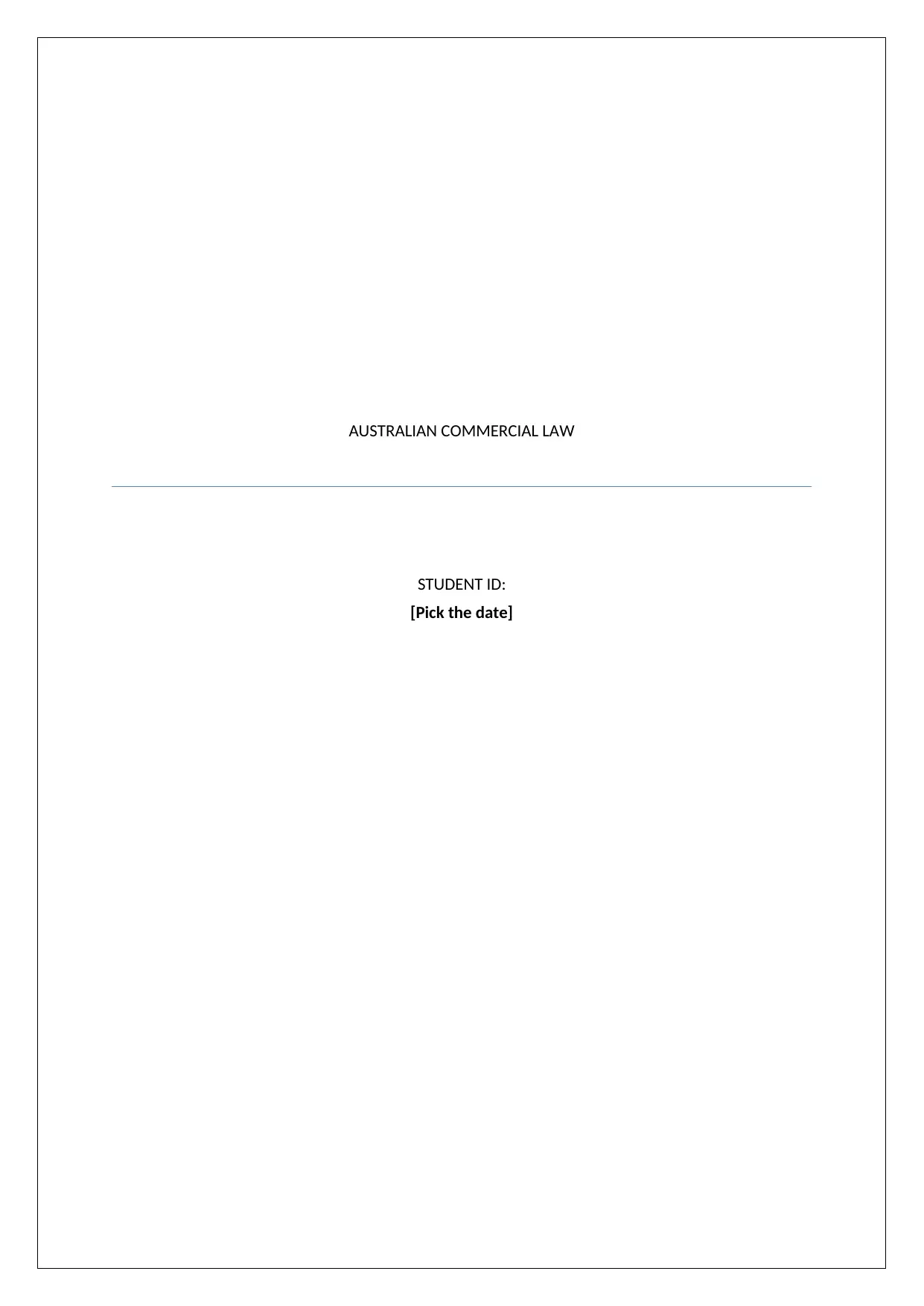
AUSTRALIAN COMMERCIAL LAW
STUDENT ID:
[Pick the date]
STUDENT ID:
[Pick the date]
Paraphrase This Document
Need a fresh take? Get an instant paraphrase of this document with our AI Paraphraser

PART A
Question 1(b)
The foreign legal system that has been shortlisted for the purposes of the given task belongs
to the United Kingdom. The various aspects of law in relation to Hart’s 3 part legal system
are highlighted below.
Rule of recognition
In order for the rule of recognition to exist, the underlying legal system must identify clear
and identifiable sources of law. This is clearly apparent for the UK legal system where there
are mainly three key sources of law, One of these is the statute law which essentially would
encompass the laws made through legislation by the requisite parliament or other bodies. In
the absence of a written constitution, common law plays a significant role as it highlights the
key principles as identified in cases from the past but these principles are relevant today.
Considering that till recently, UK was part o the European Union, thus, the legal system is
also influenced by corresponding laws enacted in the EU especially related to human and
labour rights1.
In this context, the existing legal system in Australia is quite comparable. The most
noticeable difference would be in relation to the source of law where for UK, constitution
does not serve as a source of law which is unlike the system in Australia where constitution
has significant importance and the highest courts do not allow formation of any law which
contravenes with the constitution
Rule of Change
In UK, there are defined ways in which the old laws may be repealing while the new ones can
be formed. The process of rule making is based on the various conventions which has been
established over the years. Additionally, the UK legal system also allows the people to
participate in the process of changing laws through the petition system which ensures that the
laws made tend to be representative of the aspirations of the people. Further, considering that
there is no written constitution, hence under UK system , the Parliament has unfettered
powers to bring change subject to judicial review2.
1 SOAS, Source of UK Law, (n.d) https://www.soas.ac.uk/library/subjects/law/research/file70249.pdf
Question 1(b)
The foreign legal system that has been shortlisted for the purposes of the given task belongs
to the United Kingdom. The various aspects of law in relation to Hart’s 3 part legal system
are highlighted below.
Rule of recognition
In order for the rule of recognition to exist, the underlying legal system must identify clear
and identifiable sources of law. This is clearly apparent for the UK legal system where there
are mainly three key sources of law, One of these is the statute law which essentially would
encompass the laws made through legislation by the requisite parliament or other bodies. In
the absence of a written constitution, common law plays a significant role as it highlights the
key principles as identified in cases from the past but these principles are relevant today.
Considering that till recently, UK was part o the European Union, thus, the legal system is
also influenced by corresponding laws enacted in the EU especially related to human and
labour rights1.
In this context, the existing legal system in Australia is quite comparable. The most
noticeable difference would be in relation to the source of law where for UK, constitution
does not serve as a source of law which is unlike the system in Australia where constitution
has significant importance and the highest courts do not allow formation of any law which
contravenes with the constitution
Rule of Change
In UK, there are defined ways in which the old laws may be repealing while the new ones can
be formed. The process of rule making is based on the various conventions which has been
established over the years. Additionally, the UK legal system also allows the people to
participate in the process of changing laws through the petition system which ensures that the
laws made tend to be representative of the aspirations of the people. Further, considering that
there is no written constitution, hence under UK system , the Parliament has unfettered
powers to bring change subject to judicial review2.
1 SOAS, Source of UK Law, (n.d) https://www.soas.ac.uk/library/subjects/law/research/file70249.pdf
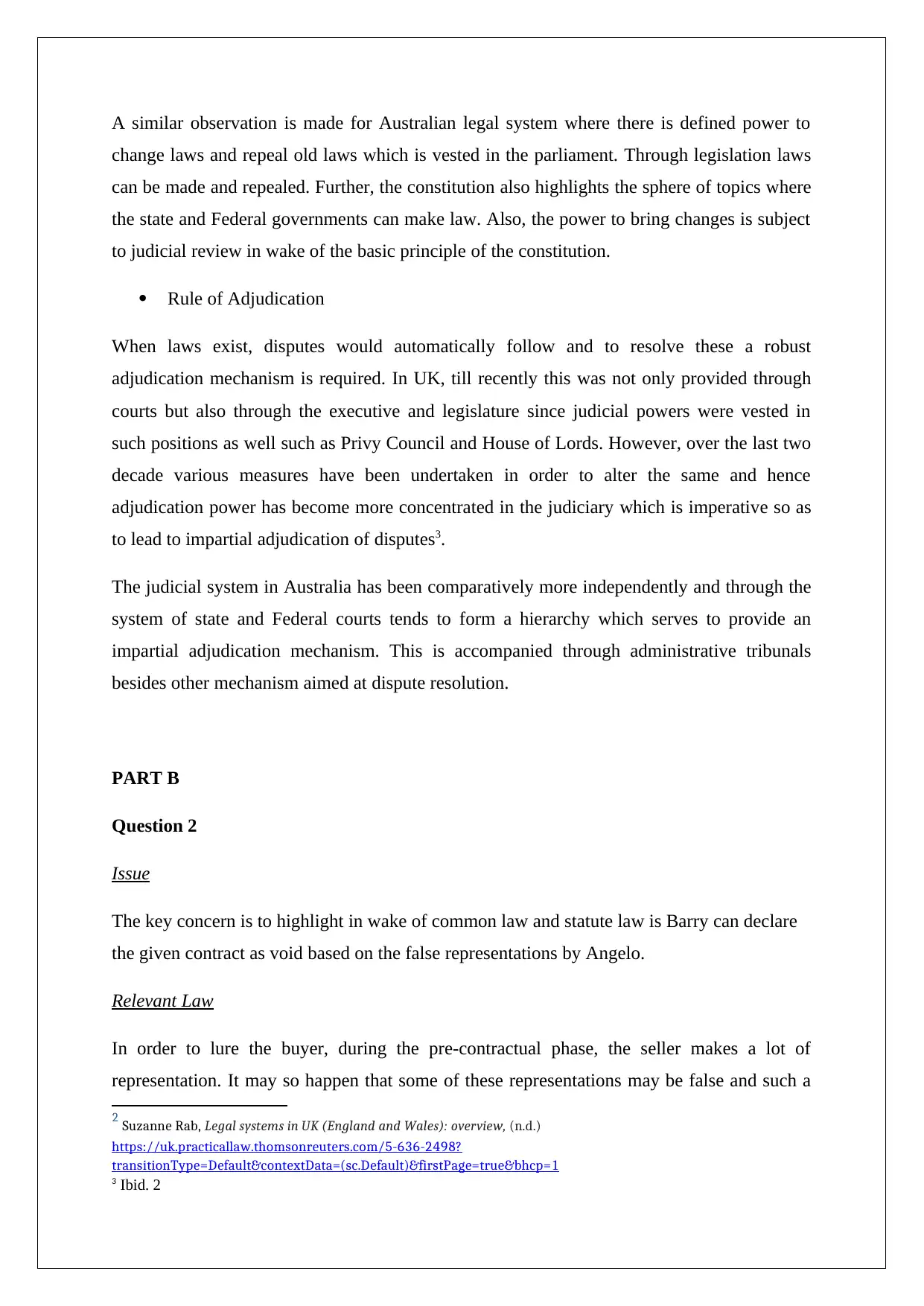
A similar observation is made for Australian legal system where there is defined power to
change laws and repeal old laws which is vested in the parliament. Through legislation laws
can be made and repealed. Further, the constitution also highlights the sphere of topics where
the state and Federal governments can make law. Also, the power to bring changes is subject
to judicial review in wake of the basic principle of the constitution.
Rule of Adjudication
When laws exist, disputes would automatically follow and to resolve these a robust
adjudication mechanism is required. In UK, till recently this was not only provided through
courts but also through the executive and legislature since judicial powers were vested in
such positions as well such as Privy Council and House of Lords. However, over the last two
decade various measures have been undertaken in order to alter the same and hence
adjudication power has become more concentrated in the judiciary which is imperative so as
to lead to impartial adjudication of disputes3.
The judicial system in Australia has been comparatively more independently and through the
system of state and Federal courts tends to form a hierarchy which serves to provide an
impartial adjudication mechanism. This is accompanied through administrative tribunals
besides other mechanism aimed at dispute resolution.
PART B
Question 2
Issue
The key concern is to highlight in wake of common law and statute law is Barry can declare
the given contract as void based on the false representations by Angelo.
Relevant Law
In order to lure the buyer, during the pre-contractual phase, the seller makes a lot of
representation. It may so happen that some of these representations may be false and such a
2 Suzanne Rab, Legal systems in UK (England and Wales): overview, (n.d.)
https://uk.practicallaw.thomsonreuters.com/5-636-2498?
transitionType=Default&contextData=(sc.Default)&firstPage=true&bhcp=1
3 Ibid. 2
change laws and repeal old laws which is vested in the parliament. Through legislation laws
can be made and repealed. Further, the constitution also highlights the sphere of topics where
the state and Federal governments can make law. Also, the power to bring changes is subject
to judicial review in wake of the basic principle of the constitution.
Rule of Adjudication
When laws exist, disputes would automatically follow and to resolve these a robust
adjudication mechanism is required. In UK, till recently this was not only provided through
courts but also through the executive and legislature since judicial powers were vested in
such positions as well such as Privy Council and House of Lords. However, over the last two
decade various measures have been undertaken in order to alter the same and hence
adjudication power has become more concentrated in the judiciary which is imperative so as
to lead to impartial adjudication of disputes3.
The judicial system in Australia has been comparatively more independently and through the
system of state and Federal courts tends to form a hierarchy which serves to provide an
impartial adjudication mechanism. This is accompanied through administrative tribunals
besides other mechanism aimed at dispute resolution.
PART B
Question 2
Issue
The key concern is to highlight in wake of common law and statute law is Barry can declare
the given contract as void based on the false representations by Angelo.
Relevant Law
In order to lure the buyer, during the pre-contractual phase, the seller makes a lot of
representation. It may so happen that some of these representations may be false and such a
2 Suzanne Rab, Legal systems in UK (England and Wales): overview, (n.d.)
https://uk.practicallaw.thomsonreuters.com/5-636-2498?
transitionType=Default&contextData=(sc.Default)&firstPage=true&bhcp=1
3 Ibid. 2
⊘ This is a preview!⊘
Do you want full access?
Subscribe today to unlock all pages.

Trusted by 1+ million students worldwide

situation is referred to as misrepresentation. This false representation may be intentional, due
to mistake or arising out of negligence of seller. Fraudulent misrepresentation denotes a
specific situation where the seller on purpose makes false representations so as to ink the
contract with the buyer. Any contract enacted through fraudulent misrepresentation would be
considered as voidable which implies that the innocent party can make it void as per will.
Besides, for financial losses, the innocent party can also demand damages from the accused
party4.
For proving existence misrepresentation, the below mentioned two conditions need to be
established based on the case facts.
1) The statement that the representor has misrepresented should be factual and not opinion
based – This is crucial since opinions are essentially self –assessment and hence it is
difficult to establish misrepresentation in such cases However, facts are irrefutable
statements which can be proved beyond any doubt. Thus, for misrepresentation to occur, it
is imperative that the representor must falsely state particular factual information. Besides,
in cases where the representor has remained silent, misrepresentation cannot be
established. Any misrepresentation owing to assumptions of the buyer would not amount
to misrepresentation5.
2) The misrepresented factual information should be important for the representee in context
of the decision making whether to enter into contractual relation or not- The insertion of
this condition is on account of ensuring that the misrepresented fact should be of
significance to enactment of contract. Further, a crucial aspect is that the buyer if given a
change to verify the representations made by seller before enactment of contract must not
behave in a negligent manner. The evidence of this can be made from the decision of the
honourable court in the Redgrave v Hurd6 case where the negligence of the representee
implied that the contract was valid.
In addition to the common law, the Australian Consumer Law in the form of Competition
and Consumer Act, 2010 could apply to the given situation. In accordance to s. 54, for any
product which is sold to consumer, there is an inherent consumer guarantee that there is
disclosure of any security on the same. Violation of this provides the right to the consumer
4 Andy Gibson, Douglas Fraser, Business Law (Pearson Publications., 8th e, 2014)
5 Ibid. 4, pp. 67-69
6 Redgrave v Hurd (1881) 20 Ch D 1
to mistake or arising out of negligence of seller. Fraudulent misrepresentation denotes a
specific situation where the seller on purpose makes false representations so as to ink the
contract with the buyer. Any contract enacted through fraudulent misrepresentation would be
considered as voidable which implies that the innocent party can make it void as per will.
Besides, for financial losses, the innocent party can also demand damages from the accused
party4.
For proving existence misrepresentation, the below mentioned two conditions need to be
established based on the case facts.
1) The statement that the representor has misrepresented should be factual and not opinion
based – This is crucial since opinions are essentially self –assessment and hence it is
difficult to establish misrepresentation in such cases However, facts are irrefutable
statements which can be proved beyond any doubt. Thus, for misrepresentation to occur, it
is imperative that the representor must falsely state particular factual information. Besides,
in cases where the representor has remained silent, misrepresentation cannot be
established. Any misrepresentation owing to assumptions of the buyer would not amount
to misrepresentation5.
2) The misrepresented factual information should be important for the representee in context
of the decision making whether to enter into contractual relation or not- The insertion of
this condition is on account of ensuring that the misrepresented fact should be of
significance to enactment of contract. Further, a crucial aspect is that the buyer if given a
change to verify the representations made by seller before enactment of contract must not
behave in a negligent manner. The evidence of this can be made from the decision of the
honourable court in the Redgrave v Hurd6 case where the negligence of the representee
implied that the contract was valid.
In addition to the common law, the Australian Consumer Law in the form of Competition
and Consumer Act, 2010 could apply to the given situation. In accordance to s. 54, for any
product which is sold to consumer, there is an inherent consumer guarantee that there is
disclosure of any security on the same. Violation of this provides the right to the consumer
4 Andy Gibson, Douglas Fraser, Business Law (Pearson Publications., 8th e, 2014)
5 Ibid. 4, pp. 67-69
6 Redgrave v Hurd (1881) 20 Ch D 1
Paraphrase This Document
Need a fresh take? Get an instant paraphrase of this document with our AI Paraphraser
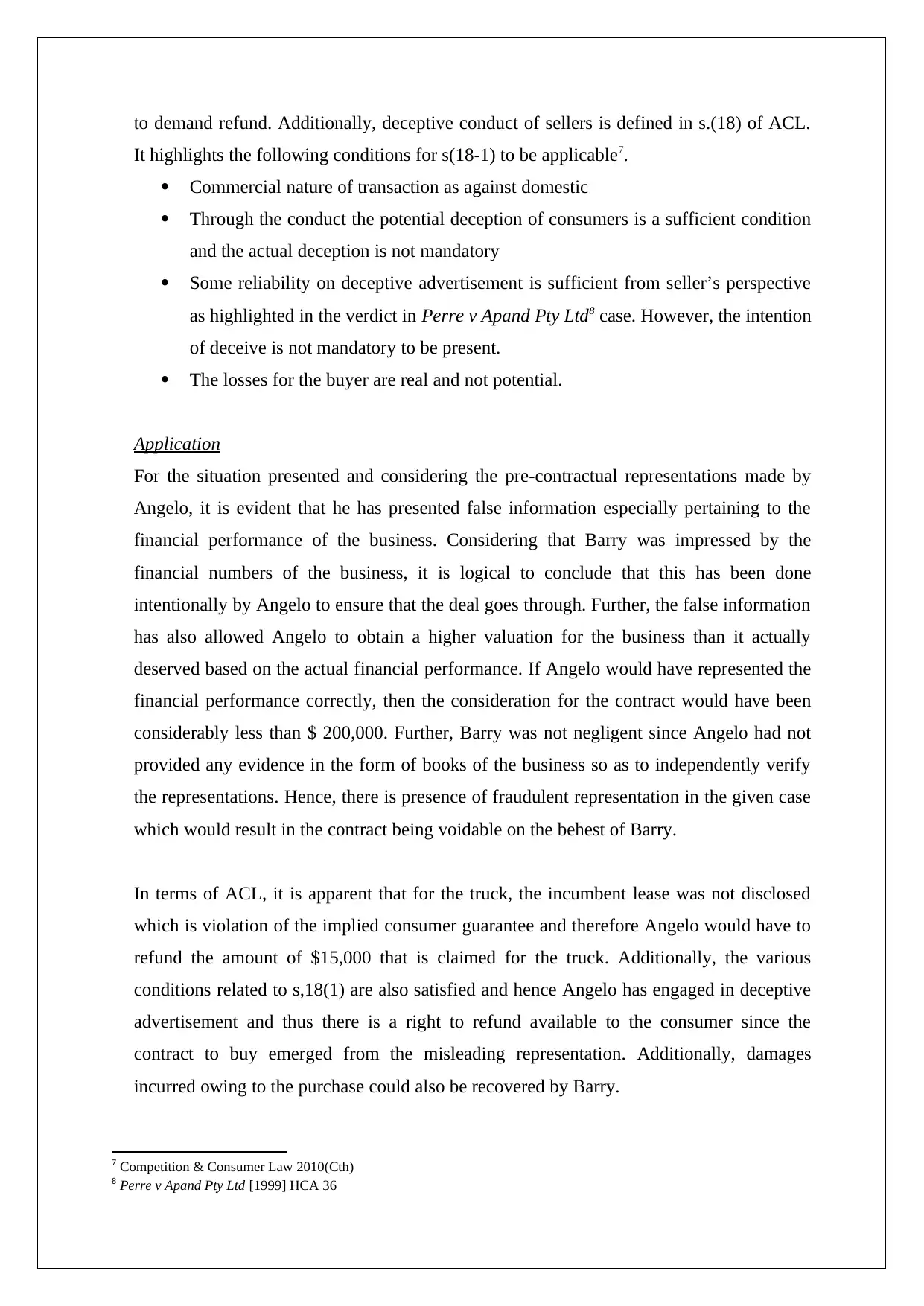
to demand refund. Additionally, deceptive conduct of sellers is defined in s.(18) of ACL.
It highlights the following conditions for s(18-1) to be applicable7.
Commercial nature of transaction as against domestic
Through the conduct the potential deception of consumers is a sufficient condition
and the actual deception is not mandatory
Some reliability on deceptive advertisement is sufficient from seller’s perspective
as highlighted in the verdict in Perre v Apand Pty Ltd8 case. However, the intention
of deceive is not mandatory to be present.
The losses for the buyer are real and not potential.
Application
For the situation presented and considering the pre-contractual representations made by
Angelo, it is evident that he has presented false information especially pertaining to the
financial performance of the business. Considering that Barry was impressed by the
financial numbers of the business, it is logical to conclude that this has been done
intentionally by Angelo to ensure that the deal goes through. Further, the false information
has also allowed Angelo to obtain a higher valuation for the business than it actually
deserved based on the actual financial performance. If Angelo would have represented the
financial performance correctly, then the consideration for the contract would have been
considerably less than $ 200,000. Further, Barry was not negligent since Angelo had not
provided any evidence in the form of books of the business so as to independently verify
the representations. Hence, there is presence of fraudulent representation in the given case
which would result in the contract being voidable on the behest of Barry.
In terms of ACL, it is apparent that for the truck, the incumbent lease was not disclosed
which is violation of the implied consumer guarantee and therefore Angelo would have to
refund the amount of $15,000 that is claimed for the truck. Additionally, the various
conditions related to s,18(1) are also satisfied and hence Angelo has engaged in deceptive
advertisement and thus there is a right to refund available to the consumer since the
contract to buy emerged from the misleading representation. Additionally, damages
incurred owing to the purchase could also be recovered by Barry.
7 Competition & Consumer Law 2010(Cth)
8 Perre v Apand Pty Ltd [1999] HCA 36
It highlights the following conditions for s(18-1) to be applicable7.
Commercial nature of transaction as against domestic
Through the conduct the potential deception of consumers is a sufficient condition
and the actual deception is not mandatory
Some reliability on deceptive advertisement is sufficient from seller’s perspective
as highlighted in the verdict in Perre v Apand Pty Ltd8 case. However, the intention
of deceive is not mandatory to be present.
The losses for the buyer are real and not potential.
Application
For the situation presented and considering the pre-contractual representations made by
Angelo, it is evident that he has presented false information especially pertaining to the
financial performance of the business. Considering that Barry was impressed by the
financial numbers of the business, it is logical to conclude that this has been done
intentionally by Angelo to ensure that the deal goes through. Further, the false information
has also allowed Angelo to obtain a higher valuation for the business than it actually
deserved based on the actual financial performance. If Angelo would have represented the
financial performance correctly, then the consideration for the contract would have been
considerably less than $ 200,000. Further, Barry was not negligent since Angelo had not
provided any evidence in the form of books of the business so as to independently verify
the representations. Hence, there is presence of fraudulent representation in the given case
which would result in the contract being voidable on the behest of Barry.
In terms of ACL, it is apparent that for the truck, the incumbent lease was not disclosed
which is violation of the implied consumer guarantee and therefore Angelo would have to
refund the amount of $15,000 that is claimed for the truck. Additionally, the various
conditions related to s,18(1) are also satisfied and hence Angelo has engaged in deceptive
advertisement and thus there is a right to refund available to the consumer since the
contract to buy emerged from the misleading representation. Additionally, damages
incurred owing to the purchase could also be recovered by Barry.
7 Competition & Consumer Law 2010(Cth)
8 Perre v Apand Pty Ltd [1999] HCA 36
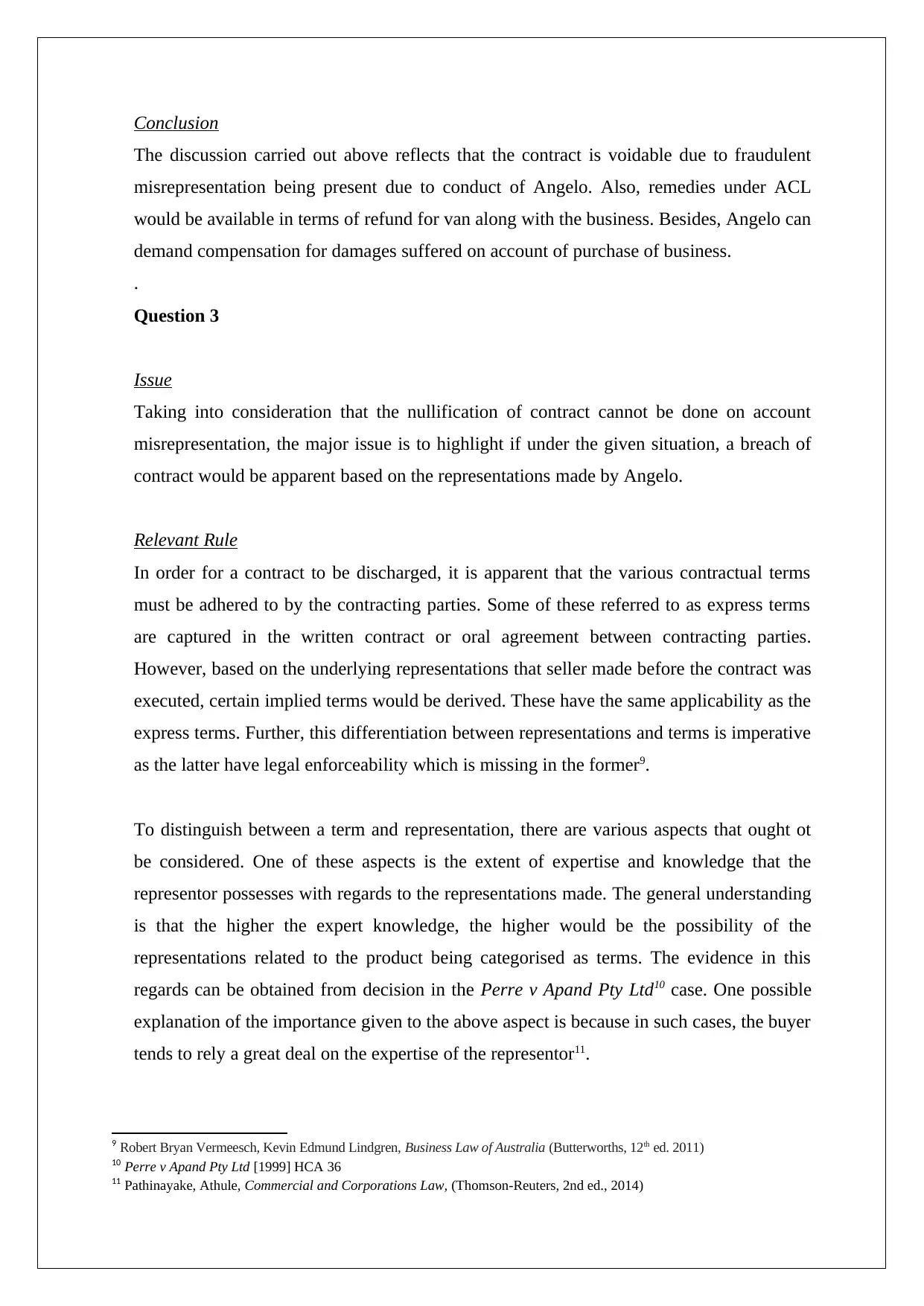
Conclusion
The discussion carried out above reflects that the contract is voidable due to fraudulent
misrepresentation being present due to conduct of Angelo. Also, remedies under ACL
would be available in terms of refund for van along with the business. Besides, Angelo can
demand compensation for damages suffered on account of purchase of business.
.
Question 3
Issue
Taking into consideration that the nullification of contract cannot be done on account
misrepresentation, the major issue is to highlight if under the given situation, a breach of
contract would be apparent based on the representations made by Angelo.
Relevant Rule
In order for a contract to be discharged, it is apparent that the various contractual terms
must be adhered to by the contracting parties. Some of these referred to as express terms
are captured in the written contract or oral agreement between contracting parties.
However, based on the underlying representations that seller made before the contract was
executed, certain implied terms would be derived. These have the same applicability as the
express terms. Further, this differentiation between representations and terms is imperative
as the latter have legal enforceability which is missing in the former9.
To distinguish between a term and representation, there are various aspects that ought ot
be considered. One of these aspects is the extent of expertise and knowledge that the
representor possesses with regards to the representations made. The general understanding
is that the higher the expert knowledge, the higher would be the possibility of the
representations related to the product being categorised as terms. The evidence in this
regards can be obtained from decision in the Perre v Apand Pty Ltd10 case. One possible
explanation of the importance given to the above aspect is because in such cases, the buyer
tends to rely a great deal on the expertise of the representor11.
9 Robert Bryan Vermeesch, Kevin Edmund Lindgren, Business Law of Australia (Butterworths, 12th ed. 2011)
10 Perre v Apand Pty Ltd [1999] HCA 36
11 Pathinayake, Athule, Commercial and Corporations Law, (Thomson-Reuters, 2nd ed., 2014)
The discussion carried out above reflects that the contract is voidable due to fraudulent
misrepresentation being present due to conduct of Angelo. Also, remedies under ACL
would be available in terms of refund for van along with the business. Besides, Angelo can
demand compensation for damages suffered on account of purchase of business.
.
Question 3
Issue
Taking into consideration that the nullification of contract cannot be done on account
misrepresentation, the major issue is to highlight if under the given situation, a breach of
contract would be apparent based on the representations made by Angelo.
Relevant Rule
In order for a contract to be discharged, it is apparent that the various contractual terms
must be adhered to by the contracting parties. Some of these referred to as express terms
are captured in the written contract or oral agreement between contracting parties.
However, based on the underlying representations that seller made before the contract was
executed, certain implied terms would be derived. These have the same applicability as the
express terms. Further, this differentiation between representations and terms is imperative
as the latter have legal enforceability which is missing in the former9.
To distinguish between a term and representation, there are various aspects that ought ot
be considered. One of these aspects is the extent of expertise and knowledge that the
representor possesses with regards to the representations made. The general understanding
is that the higher the expert knowledge, the higher would be the possibility of the
representations related to the product being categorised as terms. The evidence in this
regards can be obtained from decision in the Perre v Apand Pty Ltd10 case. One possible
explanation of the importance given to the above aspect is because in such cases, the buyer
tends to rely a great deal on the expertise of the representor11.
9 Robert Bryan Vermeesch, Kevin Edmund Lindgren, Business Law of Australia (Butterworths, 12th ed. 2011)
10 Perre v Apand Pty Ltd [1999] HCA 36
11 Pathinayake, Athule, Commercial and Corporations Law, (Thomson-Reuters, 2nd ed., 2014)
⊘ This is a preview!⊘
Do you want full access?
Subscribe today to unlock all pages.

Trusted by 1+ million students worldwide

Another aspect worth considering is the significance of the representation from the point
of view of the representee. The higher the importance given to the representation, the
greater are the chances of the representation being considered as the term of contract. In
order to elaborate the same, the decision pronounced in the Bannerman v White12 case
assumes significance. In this case, the plaintiff has clearly highlighted that hops need to
have undergone sulphur treatment failing which he would not buy them. This statement
clearly reflected that sulphur treatment for the buyer was so pivotal that it could influence
the decision to enter into contract or not. Hence, the court considered this as an implicit
term for this contract and since the seller had provided hops without sulphur treatment,
hence the contract was breached13.
An additional aspect relates to parole evidence rule as per which the representations which
ought to be contractual terms are usually captured in the written contract while those not
so relevant or mere representations continue to remain in oral form. However, this must be
used in conjunction along with other parameters.
Application
As per the applicable rule highlighted above, it needs to identify as to which
representations in accordance with different factors outlined above can be classified as
terms of the contract in the given case. Based on the details provided, it becomes clear that
Barry was clearly quite impressed with the financial performance and therefore called
Angelo to discuss the other aspects of the business. Further, in order to ascertain the fair
value of any business, a key factor that is considered is the periodic profits made by the
business. Hence, it would be appropriate to consider the representations regarding the
monthly expense and monthly revenue as terms as violation of the same could have
impacted the outcome of the contract. Besides, the representation made by Angel also
become more pivotal in this case since Barry does not have any experience with the given
business and hence he is relying on the expertise that Angelo possesses with regards to his
business. Also, in wake of the actual values of monthly revenue and expense, it might
have been possible that Barry would not buy the business and may consider his
employment salary to be higher14.
12 Bannerman v White (1861) 10 CBNS 844
13 Pendleton, Wayne & Vickery, Roger, Australian business law: principles and applications, (Pearson Publications, 5th ed.,
2015)
14 Ibid, 11, p.123-124
of view of the representee. The higher the importance given to the representation, the
greater are the chances of the representation being considered as the term of contract. In
order to elaborate the same, the decision pronounced in the Bannerman v White12 case
assumes significance. In this case, the plaintiff has clearly highlighted that hops need to
have undergone sulphur treatment failing which he would not buy them. This statement
clearly reflected that sulphur treatment for the buyer was so pivotal that it could influence
the decision to enter into contract or not. Hence, the court considered this as an implicit
term for this contract and since the seller had provided hops without sulphur treatment,
hence the contract was breached13.
An additional aspect relates to parole evidence rule as per which the representations which
ought to be contractual terms are usually captured in the written contract while those not
so relevant or mere representations continue to remain in oral form. However, this must be
used in conjunction along with other parameters.
Application
As per the applicable rule highlighted above, it needs to identify as to which
representations in accordance with different factors outlined above can be classified as
terms of the contract in the given case. Based on the details provided, it becomes clear that
Barry was clearly quite impressed with the financial performance and therefore called
Angelo to discuss the other aspects of the business. Further, in order to ascertain the fair
value of any business, a key factor that is considered is the periodic profits made by the
business. Hence, it would be appropriate to consider the representations regarding the
monthly expense and monthly revenue as terms as violation of the same could have
impacted the outcome of the contract. Besides, the representation made by Angel also
become more pivotal in this case since Barry does not have any experience with the given
business and hence he is relying on the expertise that Angelo possesses with regards to his
business. Also, in wake of the actual values of monthly revenue and expense, it might
have been possible that Barry would not buy the business and may consider his
employment salary to be higher14.
12 Bannerman v White (1861) 10 CBNS 844
13 Pendleton, Wayne & Vickery, Roger, Australian business law: principles and applications, (Pearson Publications, 5th ed.,
2015)
14 Ibid, 11, p.123-124
Paraphrase This Document
Need a fresh take? Get an instant paraphrase of this document with our AI Paraphraser
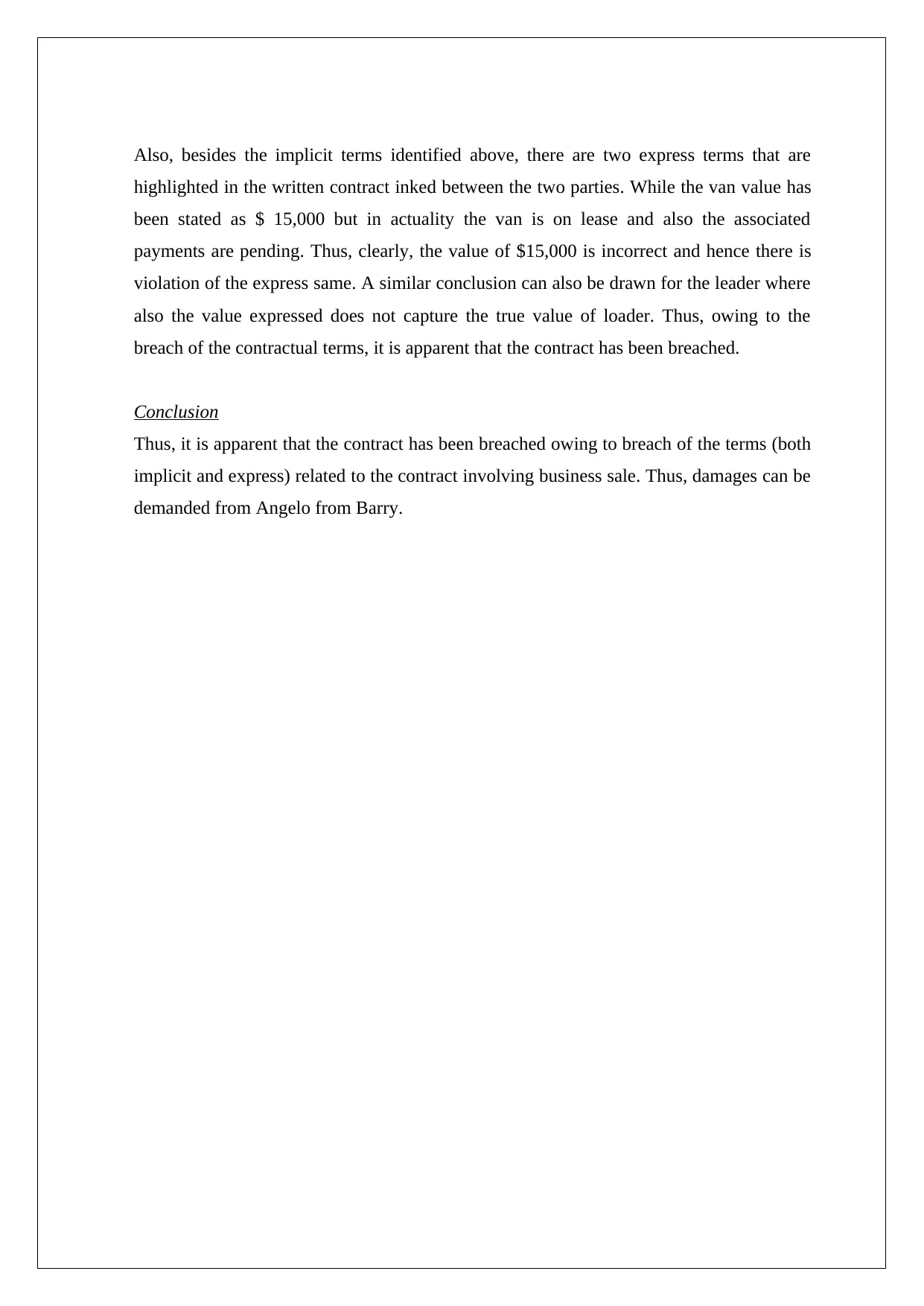
Also, besides the implicit terms identified above, there are two express terms that are
highlighted in the written contract inked between the two parties. While the van value has
been stated as $ 15,000 but in actuality the van is on lease and also the associated
payments are pending. Thus, clearly, the value of $15,000 is incorrect and hence there is
violation of the express same. A similar conclusion can also be drawn for the leader where
also the value expressed does not capture the true value of loader. Thus, owing to the
breach of the contractual terms, it is apparent that the contract has been breached.
Conclusion
Thus, it is apparent that the contract has been breached owing to breach of the terms (both
implicit and express) related to the contract involving business sale. Thus, damages can be
demanded from Angelo from Barry.
highlighted in the written contract inked between the two parties. While the van value has
been stated as $ 15,000 but in actuality the van is on lease and also the associated
payments are pending. Thus, clearly, the value of $15,000 is incorrect and hence there is
violation of the express same. A similar conclusion can also be drawn for the leader where
also the value expressed does not capture the true value of loader. Thus, owing to the
breach of the contractual terms, it is apparent that the contract has been breached.
Conclusion
Thus, it is apparent that the contract has been breached owing to breach of the terms (both
implicit and express) related to the contract involving business sale. Thus, damages can be
demanded from Angelo from Barry.
1 out of 8
Related Documents
Your All-in-One AI-Powered Toolkit for Academic Success.
+13062052269
info@desklib.com
Available 24*7 on WhatsApp / Email
![[object Object]](/_next/static/media/star-bottom.7253800d.svg)
Unlock your academic potential
Copyright © 2020–2025 A2Z Services. All Rights Reserved. Developed and managed by ZUCOL.





